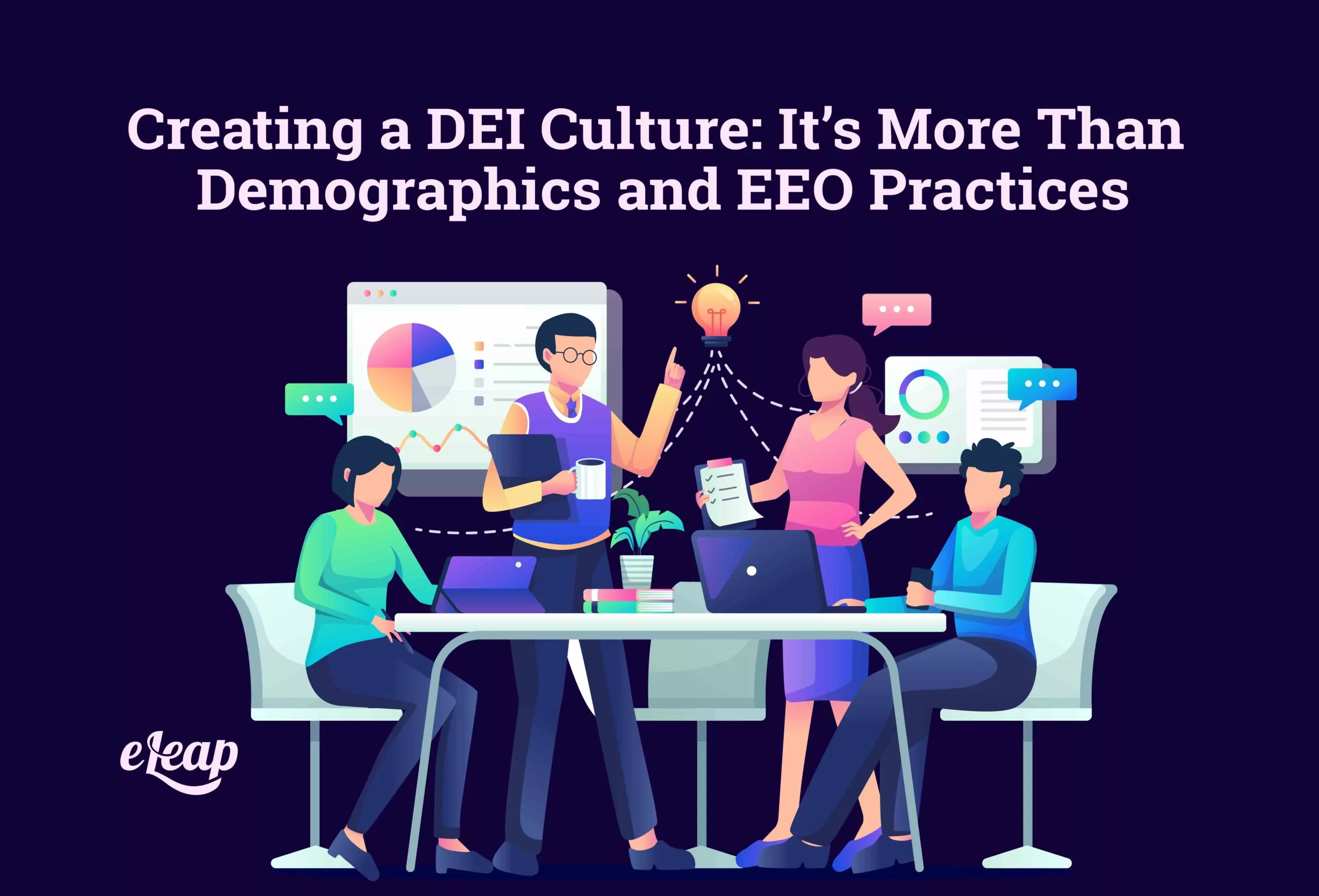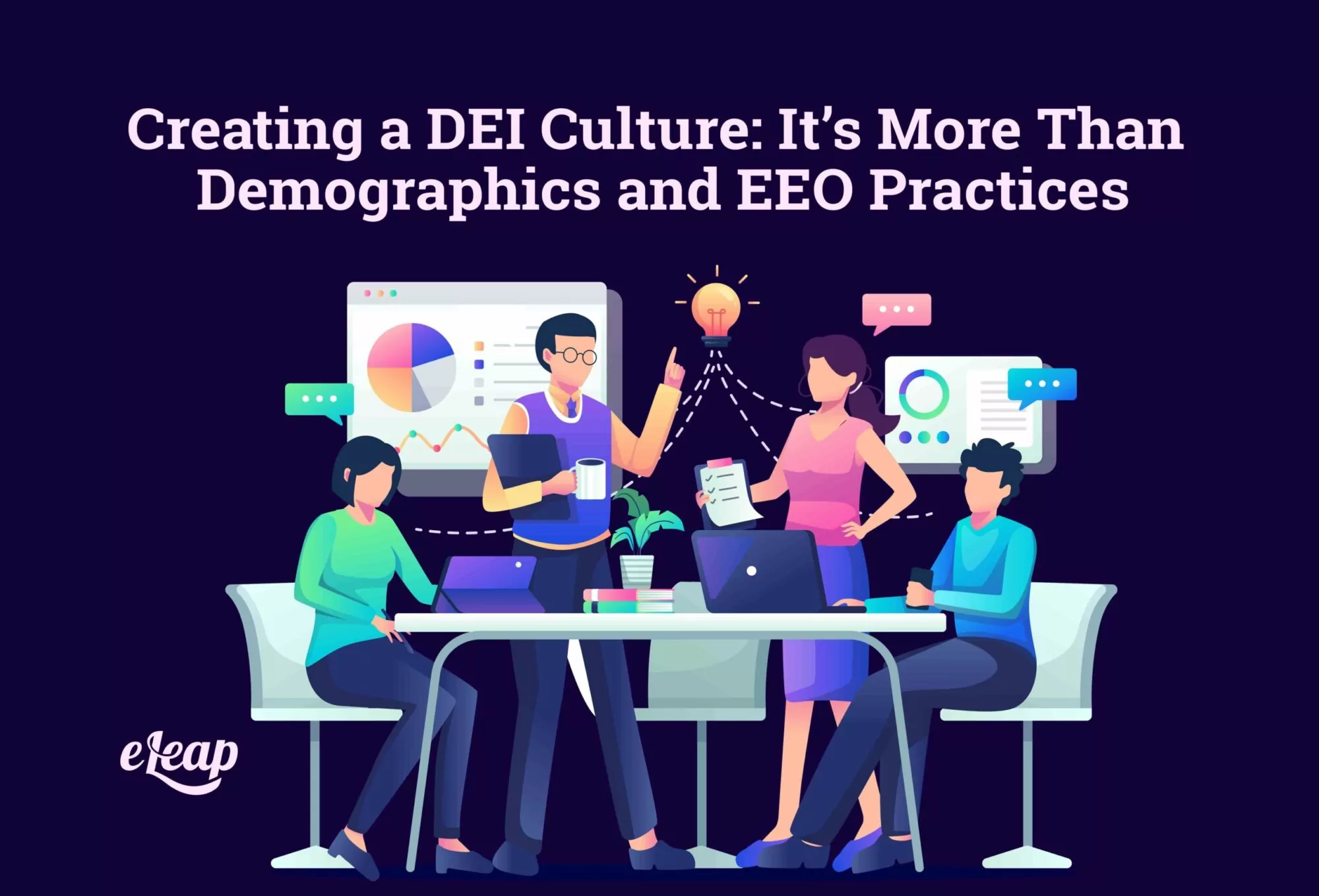Creating a DEI Culture: It’s More Than Demographics and EEO Practices

In the past, “diversity and inclusion” referred mostly to things like gender, sex, race, educational background, and so forth. Companies have been encouraged for decades to build a diverse workforce and many focused on these factors without realizing how much more is involved under the umbrella of DEI, or diversity, equity, and inclusion. While the aforementioned differences may be a part of it, they’re only a small part. With the growing competition in the new global workforce, organizations are looking to find other ways to grow their own DEI culture.
In this guide, we’ll take a deeper look at what a DEI culture entails and how your organization can get on board by creating a safe space where diversity and differences are welcomed as a positive asset to the business and its various processes.

What is a DEI Culture?
Embracing a culture that commits to diversity, equity, and inclusion means keeping an open mind, developing inclusive leaders, implementing proper diversity and inclusion training and education for employees and managers, and so forth. It’s a process of ensuring that everyone feels comfortable, welcome, and like they’re a part of the organization. The employee collective will help each individual feel like they can take ownership of the workplace culture.
Then, everyone will be invested in improving the culture in every area of the business possible. Organizations that recognize and welcome employee contributions to the DEI culture will see much quicker adoption from employees and leaders alike. This will also help drive change at all levels of the organization.
Beyond Demographics
Yes, the big focus on diversity and inclusion is the diversity of workers in terms of age, sex, gender, socioeconomic status, ethnicity, etc. However, there’s more to it than that. When you go beyond demographics, there are several ways that you can embrace diversity and inclusion by segmenting or identifying different employees or teams that offer a different perspective or capability that you do not currently have.
It’s about choosing diversity in:
- Educational backgrounds
- Professional backgrounds
- Personalities
- Learning styles
- Working styles
- And so forth
The more diverse the organization, the more likely it will be to stand the test of time and have the best chances of standing up against the competition.
Six Traits of Inclusive Leadership
According to Harvard Business Review, there are six traits, also known as the 6 C’s, that signify inclusive leadership:
- Commitment: It’s not just about commitment to the organization. There also must be a serious, honored commitment to diversity inclusion; perhaps even so much so that the business objectives align with their personal values, and they take action to ensure that all team members feel connected and appreciated.
- Cognizance of bias: This essentially means that leaders are aware of their own behavior, how they come off to others, and how they can self-regulate themselves and ensure fair play. They are aware of their personal biases and blind spots that could prevent them from making unbiased decisions and will seek assistance while also addressing organizational processes that are inconsistent and need clear explanations and reasons.
- Collaboration: Group intelligence is the new norm. A diverse team that can think and collaborates is much greater than the individuals within it. Those highly inclusive leaders are capable of empowering team members to handle challenges or make decisions about their work. They also create collaborative efforts between teams and team members and are responsible for ensuring a safe environment where all employees feel comfortable speaking their minds.
- Courage: When you have to talk about imperfections or weaknesses, you’re taking a personal risk. That takes a lot of courage and is why the best leaders are those courageous enough to stand up, speak up against the status quo, and acknowledge their shortcomings, mistakes, and personal limits. They also dare to hold others accountable for behaviors that go against the DEI culture.
- Cultural intelligence: This ties in with curiosity, to an extent, and is the level of cross-cultural experience leaders have and how confident they are in those interactions. Leaders that have demonstrated an active interest in creating and exploring culturally diverse environments and they can modify their style to the encounter at hand, using necessary non-verbal and verbal behaviors.
- Curiosity: Curiosity is an active trait and it’s one that leaders today exemplify. Leaders need to show appreciative inquiry and have an open mind. They need a true desire to know their employees and they should encourage divergent thinking, brainstorming, and unique ideas that allow everyone to see the world through different cultural perspectives.
When leaders and managers understand what it means to be inclusive, they are in a much better position for success. It is the diversity of markets, ideas, talent, customers, and organizations that are building the business environment that we know today. Clarity among leadership and across the company will be necessary, as well.
Seven Areas to Help Create a Culture of Inclusion
Although everyone has their own strategies in mind, there are some actionable elements that organizations can guarantee will get their culture on the track to diversity and inclusion:
- Strategic alignment
- Recruitment
- Competency management and capability
- Performance management
- Recognition and rewards
- Leadership development
- System integration
By taking the time to align your organizational strategy with the tenets of diversity and inclusion, as well as to recruit more diverse talent and seek new avenues for doing so, you’ll be well on your way to improving the culture. However, you also have to include the areas of performance and competency management, as well as leadership development.
Make sure that you have recognition and rewards that are inclusive and diverse, and that your digital strategy ensures simple system integration of the diverse, inclusive leadership that you have just taken so much time to develop. With these things in mind, your DEI culture might even build itself and help you attract better talent from all corners of the world.